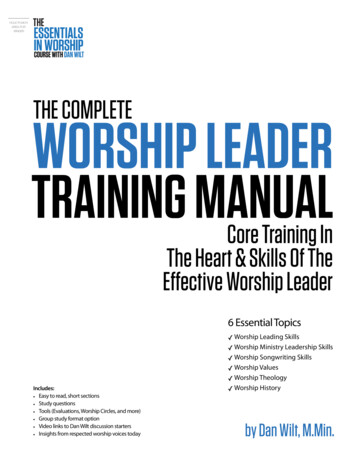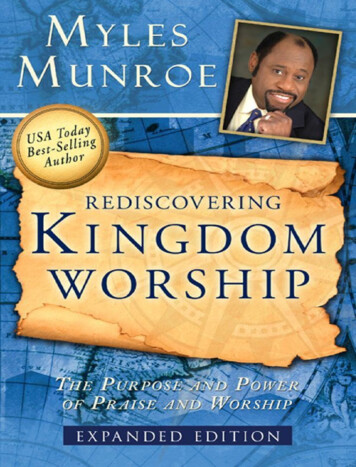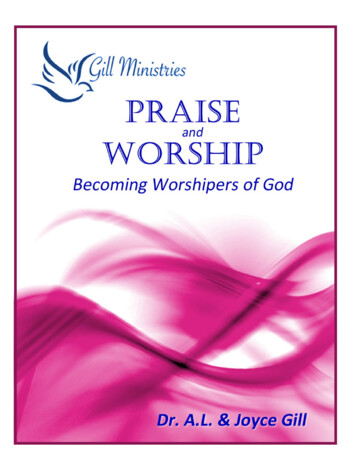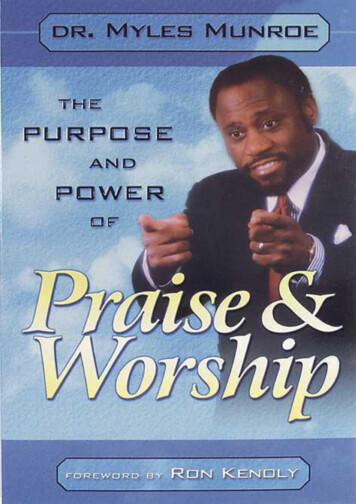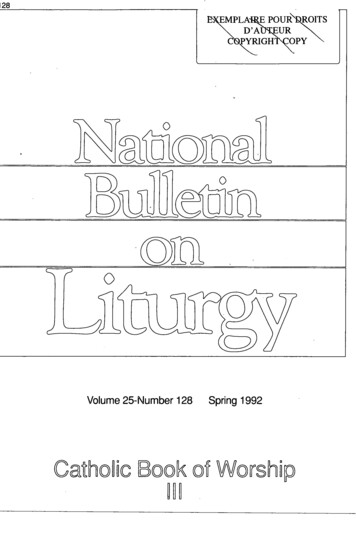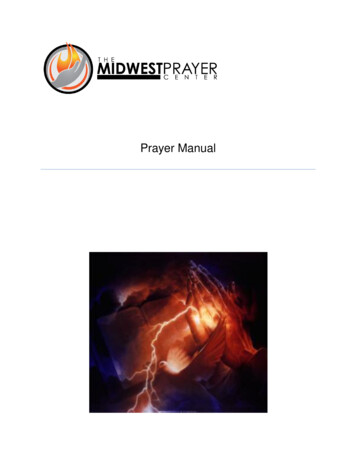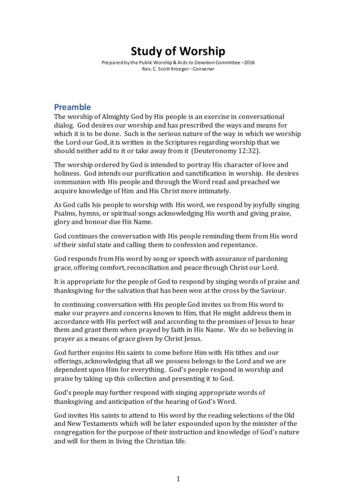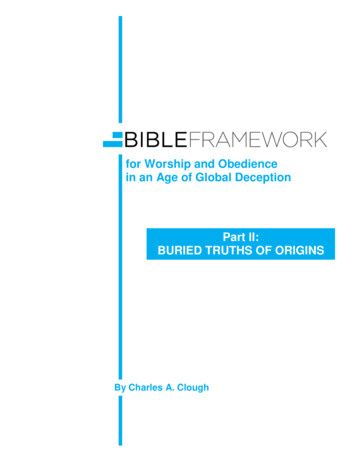
Transcription
for Worship and Obediencein an Age of Global DeceptionPart II:BURIED TRUTHS OF ORIGINSBy Charles A. Clough
This page was intentionally left blank for proper double sided printing. 1995, Charles A. CloughBible Framew ork M inistriesw w w .biblefram ew ork.org
P art I I P age iPreface to:Lesson 1A BIBLICAL FRAMEWORK FOR WORSHIP AND OBEDIENCEIN AN AGE OF GLOBAL DECEPTIONWHY THIS COURSE?With all the Bible studies, conferences, and special seminars, why should there yetbe another course? Good question. Let me explain.I became a Christian while studying math and science at the Massachusetts Instituteof Technology. I quickly became aware of the sharp and total conflict between thebiblical worldview and modern culture. Either the Bible was what it claimed to be, therevealed Word of God and therefore the ultimate standard of truth for every area of life,or it was false in its claim and just another ancient book of passing interest.If the Bible were not the verbal revelation of the Living God, then I could be my ownultimate authority. That sounded like pretty heady stuff until I realized the implications—no objective meaning in life, no transcendental moral guidance or empowerment, andnot even solid criteria for deciding truth and falsehood. Another sobering implicationwould be that the greatest person who ever lived, Jesus Christ, was either a fraud or afiction.On the other hand, if the Bible really was what it claimed to be, then my whole life hadto be radically corrected. The God of the Bible was graciously calling me to begin a veryserious process of working out repentance toward His authority in one area after anotherat ever deepening levels. He and I had an unavoidable, face-to-face appointment toevaluate permanently my response to His Word.I couldn't politely receive His story of Adam on Sundays, for example, a storyaccepted by His Son Jesus Christ, and then turn my back on Him Monday throughFriday by embracing the contradicting evolutionary premise in history and science. Icouldn't profess real ethical responsibility before His Presence, and then, to deal withpersonal crises, revert to determinist psychologies wherein I was a passive 'victim' ofcircumstances. The Bible could not be "compartmentalized" to my private religiousexperiences. Either it was true for all of life, or it could not be true for any of life.Worship and obedience had to spill over into every area.Out of my subsequent pilgrimage, including two graduate schools and the challengingexperience of ministering the Word of God in a university town, I conceived a particularapproach to teaching the Bible. Somehow, in the midst of an exploding amount ofinformation and specialization, the Bible had to be taught so that its total picture wasconstantly kept in focus over against the ever-present opposition from the world. Toshow the "big picture", the framework of implications across all domains of life, Ideveloped this course.Bible Framew ork M inistriesw w w .biblefram ew ork.org
P age ii P art I IThis biblical framework course has a unique structure that combines apologetics withelements of biblical and systematic theology. Truths of God and His working are set intotheir original niche in history to show they are as much a part of reality as any "secular"history or science. In an age when men despair of trying to find sense in life, I have triedto show the inner coherence of God's speech to us. Each part of His historicconversation is linked to every other part and to every truth outside of the Bible. The keyto life is "thinking God's thoughts after Him."This course, however, does not replace traditional Bible study; it is only a tool tointegrate them. It does not replace special scholarly investigations of godly men-although it shows how to use an apologetic strategy to isolate and encircle unbelief.Finally, it cannot substitute for worship, praise, and prayer to our Triune God out of aregenerate heart. It can, however, help to start conversations with Him!This course is a rewritten, updated version of an earlier one published between 1972and 1980. Christian friends from around the world have asked when it would again beavailable. As with the earlier version, I was guided by many godly saints of the past andpresent who were taught by His Spirit, each in their own domain, that the Word of Godjudges all things. Thankfully, they braved ridicule and sometimes fierce resistance fromtheir colleagues, to obey the Lord of all. My use of their insights, however, is my own,and I accept full responsibility for any misinterpretations or misapplications of their work.During the past 20 years, the rate of information acquisition has become a deluge.With vastly-improved data interchange, deceptions once kept localized have becomeglobal. As we all struggle to stay afloat on a virtual sea of data, much of it deceptivelyorganized against biblical faith, I believe it has become even more vital to integrate ourlives with a heart focus upon Him Who was, Who is, and Who is to come. This is theOne Who spoke the universe into existence, Who daily directs its journey through time,and Who has repeatedly and publicly spoken to mankind. He alone of all so-called godshas actually done something in history by visiting our planet to save us from our sins.And one day will utter His words of judgment on our response to Him. Let's listen anew,then, to His Word for us wherever we are in this age of global deception.Charles A. CloughBel Air, MarylandBible Framew ork M inistriesw w w .biblefram ew ork.org
P art I I P age iiiOutlineII. Buried Truths of OriginsA. Chapter 1: Biblical Creation vs. Pagan Origin-Myths1. The Importance of Originsa. Importance of Origins for Meaningb. Importance of Origins for Meaning in Modern Sciencec. No Neutral Groundi.The Religious Neutrality Theoryii. Not Neutrality but Tolerance2. Comparing Biblical Creation and Pagan Origin Mythsa. Comparison of Early Genesis with a Pagan Textb. Similarities between Genesis and Ancient Paganismc. Contrasts between Genesis and Ancient Paganismi. Creator-creature vs. Continuity of Beingii. Personal Sovereignty vs. Impersonal Chance3. Reconciling Genesis and the Evolution Origin-Mytha. The Capitulation Strategyb. The Accommodation Strategyc. The Counterattack StrategyB Chapter 2: Creation: The Buried Truth of Who God Is1. The Distinctiveness of Biblical Creationa. Who am I?b. What is Truth and How Can I know?c. How Should I Live2. How God Can and Cannot be Knowna. Trying to See God Without Opening the Eyesb. Opening the Eyes to See God3. Who and What God Isa. Some Incommunicable Attributesi. Omnipresenceii. Omnipotenceiii. Immutabilityiv. Eternityb. Some Communicable Attributesi. Sovereigntyii. Holinessiii. Loveiv.Omniscience4. Staying Out of Idolatrya. Modern Idolatryb. How to Get Out and Stay Out of IdolatryC. Chapter 3: Creation: The Buried Truth of Man and Nature1. What is Man?a. God’s Description of Man’s Creationb. The Unique Design of MankindBible Framew ork M inistriesw w w .biblefram ew ork.org
P age iv P art I IBible Framew ork M inistriesi. Man is an Image of God in Both Body and Spiritii. Through His Body, Man Rules Natureiii. All Humans are Made from Adam’s Single Bodyiv. Man Through His Spirit Chooses, Judges, Loves, Knowsa. Choiceb. Consciencec. Loved. Knowledgec. The Divine Institutionsi. Responsible Dominionii. Marriageiii. Family2. What is Nature?a. Design of Natureb. Man’s Limited Power over Naturec. Man’s Limited Rights over Natured. Man’s Limited Knowledge of Naturei. Reasonii. Experiencee. A Special Limitation in Constructing Histories of NatureD. Chapter 4: The Fall: The Buried Truth of the Origin of Evil1. Comparing the Biblical “Fall” with Pagan Mythsa. Similarities with Genesisb. Contrasts with Genesisi. Bounded Evil vs. Eternal Evilii. Responsible Guilt vs. Victimization2. Evil Under Goda. God and Responsible Creature-Choices that Originate Evilb. God Trusted without a Full Answer3. Evil In Mana. Sin-Damage to Man’s Designi. The Bodyii. The Spiritb. Sin-Damage to Man’s Institutionsi. Responsible Dominionii. Marriageiii. Family4. Evil in Naturea. Sin-Damage to Nature’s Designb. Sin-Damage to Man’s Rule over Nature5. Living with Evil: Basic Coping Strategiesa. Pagan Coping Strategiesb. Biblical Coping Strategyi. Back to Basicsii. How Much Limit on Evil Now?iii. Patterns of Sufferinga. Direct Suffering Patternsw w w .biblefram ew ork.org
P art I I P age vBible Framew ork M inistriesi.General Existence of Sickness & Deathii.General Existence of “Self-Induced Misery”iii.General Judgment Pattern: Nations & Familyiv.Eternal Existence in Hellv.Judgment as Children of Godvi.Judgment as Servants of Godb. Indirect Suffering Patternsi.Evangelistic “Wake-Up Call”ii.A “Nudge” to Spiritually Advanceiii.Evidence for Evangelization of Unbelieversiv.Evidence for Edification of Believersv.Evidence in the Unseen Angelic Conflictiv.A Faithful Worship and ObedienceE. Chapter 5: The Flood: The Buried Truth of Divine Intervention1. The Distinctiveness of the Biblical Flooda. The Depth-Time Distinctiveb. The Ark’s Distinctive Size, Design, and Purposec. The Distinctive Commentary of Peterd. The Distinctive Features of the Antediluvian World2. God’s Intervention of Judgment and Salvationa. Grace Before Judgmentb. Perfect Discriminationc. One Way of Salvationd. Replacement of the Whole Worlde. Appropriation by FaithF. Chapter 6: The Covenant: The Buried Truth of the New World1. God’s Covenant with the New Worlda. The Parties to the New World Covenantb. The Signing of the New World Covenantc. The Legal Terms of the New World Covenantd. The Founding Sacrifice of the New World Covenant2. Implications of the New World Covenant for Naturea. Nature is Bounded by the Word of Godb. The New Heavens and the New Earthc. Spiritual Lessons from the Physical Environment3. Implications of the New World Covenant for Mana. Understanding How Noah Founded the Present Civilizationb. The Re-Installed Divine Institutionsi. Responsible Dominionii. Marriageiii. Familyc. The New Divine Institution: Civil GovernmentG. Appendix A: Interpreting Genesis 1-111. Hermeneutics and Presuppositions2. Traditional Interpretation of Genesis 1-113. The Interrelated Structure of Genesis 1-114. Accommodationist Focal Pointsw w w .biblefram ew ork.org
P age vi P art I Ia. The Days of Creationb. Adam to Abraham Genealogiesc. Pre-Genesis 1 ExistenceH. Appendix B: Biological Natural History: Creation vs. Evolution1. Structural Differences between Creation and Evolution2. The Theory of Evolution and the So-Called Fact of Evolution3. Evidences Supporting Biblical Creationa. Design and Information Theoryb. Artificial and Natural Selectionc. Mutation Effects and the Falld. Systematic Gaps in the Fossil RecordI. Appendix C: Physical and Chemical Natural History: Thousands orBillions of Years Old?1. Methodologies and Presuppositions2. Terrestrial “Clocks” and the Biblea. The Biblical Age of the Earthb. The Pagan Age of the Earth3. Astronomical “Clocks” and the Biblea. The Biblical Age of the Universeb. The Pagan Age of the Universe4. Recent Cosmological Theories of Bible-Believing Scientistsa. Humphrey’s Cosmological “Water Model”b. Hermann’s Metamorphic-Anamorphic (MA) ModelJ. Appendix D: Geological Natural History: Biblical Catastrophismvs. Uniformitarianism1. Presuppositions Behind Catastrophism and Uniformitarianism2. The History of Geological Interpretation3. Flood Geology Todaya. What is the Geologic Column?b. Evidences of Out-of-Order Layers and CatastrophicSedimentationc. John Woodmorappe’s Tectonically-Associated BiologicalProvinces ModelK. Appendix E: Diagrams Used in ClassBible Framew ork M inistriesw w w .biblefram ew ork.org
P art I I P age viiINTRODUCTIONPart II of the Framework course deals with the very foundation ofbiblical faith--origins. Along with every other historical creed of theChristian Church, the familiar Apostles Creed that all Christians recite sooften begins with God as Creator: "I believe in God the Father Almighty,Maker of heaven and earth." This theme is recited again in heaven at theend of history when God is praised by His creatures: "Thou didst createall things, and because of Thy will they existed, and were created" (Rev.4:11).In this study you will see how the universe around you and even yourheart inside you have always borne clear testimony to your Creator.Their testimony is so clear that the carnal mind (being always at enmitywith God) has had to suppress this truth to try to avoid responsibilitybefore Him. Thus paganism, whether ancient or modern in form, has apowerful ethical motive in viciously and unrelentingly attacking the firsteleven chapters of Genesis as "mythological."In place of this annoying revelation, the pagan program has alwayshad to invent substitute origin-myths of its own. Only an origin-myth canso clearly express the grand unifying principle of a worldview. All itsparts are tied together by a story of how everything "came to be": "gods"or first principles, men, nature, evil, death, life, etc. A story of originsrelates living structures to non-living structures; it links observationaldata and the logic used for data analysis. In fact, an origin-myth shapesthe ultimate first principles. Just how profoundly idolatrous such asubstitute for the biblical creation narrative really is, and how lethal it isto your spiritual life, you will see in this study.Bible-believing Christians in every pagan culture have to face theproblem of their culture's officially sponsored origin-myth. In the UnitedStates and other so-called developed countries today, cosmic evolutionhas been installed as the undisputable origin-myth to which all must giveallegiance. Thousands of dissenting students and their heartbrokenparents can testify to the mental and emotional abuse they have receivedfrom the education system. Well-educated Bible-believing graduatestudents and professionals, especially in the sciences, face tenure-denial,termination of grant funding, and editorial rejection of technical papersbecause of their reluctance to go along with the evolutionary dogma.Millions of tax dollars are used to promote the evolutionary origin-mythas "neutral" objective science when instead it is a speculative model thatlies beyond direct scientific verification.Bible Framew ork M inistriesw w w .biblefram ew ork.org
P age viii P art I IThis study should encourage you to reject all such origin-mythindoctrination that so mutilates the Creator's character. Study of origins,you will learn, is not just a matter of digging up buried fossil evidencefrom the earth; it's a matter of exposing buried (suppressed) revelation inevery human heart! Energized by the god of this world and the carnalmind, the pagan program has spread its deception across manydisciplines. In the following chapters we must raise very serious conflictwith the speculative worldview being taught to us along with the realtruths in astronomy, biology, geology, anthropology, and physics.As Part II of the overall Framework course, the following chaptersbuild upon the apologetic strategy called presuppositionalism discussed inPart I. It prepares you for Part III that deals with the structure of today'scivilization and God's intrusion of His redemptive work through Israel.In the following chapters 1, 2, and 3 I discuss the creation event and itsimplications. Chapter 4 continues our study with the problem of evil andthe event of the Fall. In Chapter 5 I analyze the Noahic Flood event asrevelation of the historical judging and saving dynamics of God. Finally,Chapter 6 ends our study with the origin of today's civilization in thestrange environment of the post-Flood world. Appendices A, B, and Coffer more details on some specific topics.Some suggestions on getting the most out of this material: (1) readrepeatedly and thoroughly the Genesis text; (2) use a cross referencestudy aid to find all references to this part of Genesis elsewhere in theBible so you can see how other biblical writers understood the text; (3)interact with the exercises and pursue those questions that especiallyinterest you by going to the Appendices and suggested sources for moreextensive materials; and (4) when you can in full conscience do it, startusing what you learn about God's greatness in prayer and praise to Him."Buried Truths of Origins" is dedicated to those seek Him and want toknow Him with both heart and mind. A. W. Tozer put it well:"Essentially, salvation is the restoration of a right relation between manand his Creator, a bringing back to normal of the Creator-creaturerelation. . . .God was our original habitat and our hearts cannot but feelat home when they enter again that ancient and beautiful abode" [1].To enter again we must embrace our Creator with true faith that Heindeed is Who He claims to be in the early chapters of Genesis.Bible Framew ork M inistriesw w w .biblefram ew ork.org
P art I I P age 1CHAPTER 1: BIBLICAL CREATION vs. PAGAN ORIGIN-MYTHSLesson 2When someone talks about the origins question, he exposes his ultimatebeliefs, the ultimate presuppositions that take precedence over all else.Therefore, in spite of the apparently bewildering variety of origin accounts inthe world, this variety is quickly reduced to two basic types of views. Onetype are the truly creation stories of the Bible and of some tribal traditionshonoring the Creator-creature distinction. The other type are those that denythe Creator-creature distinction, making all reality basically of one kind.I will show you some examples in this chapter. However, before I do, Iwant to emphasize how important the origins topic is to one's worldview.You must understand that talking with someone about origins can raisesurprisingly strong emotions. You can unwittingly have a conversation blowup in your face and suddenly find yourself in a shouting match. Origins, in avery real sense, is a deeply religious and sensitive subject with most people.Finally, in this chapter I briefly describe for you the different strategiesChristians have used to try to reconcile the biblical creation story with themodern evolutionary view of origins.THE IMPORTANCE OF ORIGINSWhether you look to ancient man or modern man, you see himunavoidably thinking and talking about origins. When the ancient man waspraying about crops or telling an adventure story, he did so with images oforigins. Modern man, when he is trying to justify space exploration budgetsor explaining why his body has certain anatomical features, refers toevolutionary origins almost automatically.Why is origins always "lurking in the background" of seriousconversation? Why is it a "hot button"? Why, for example, do folks whohear about creation-evolution debates so quickly utter personally-judgmentalremarks about one side or the other?Importance of Origins for MeaningHere I must anticipate a little of Chapters 2 and 3 where therelationships of God, man, and nature are discussed. It turns out that man hasto get involved with origins whenever he gets seriously involved with themeaning of things in his life. Let's see how this works.Bible Framew ork M inistriesw w w .biblefram ew ork.org
P age 2 P art I IThe meaning of a word always involves categories and contextualassociations. Let's take the term, dog. Man learns about dogs from seeing orhearing about different kinds. There are terriers, German shepherds, and amyriad of others. Very quickly he somehow is able to define a category ofobjects called dogs. He learns that Siamese cats or Jersey cows, for example,aren't part of the class called dogs. The concept "dog" has its ownclassification niche in his thinking.Involved in this learning process about dogs are many associations.Maybe he was bitten once, or he saw a faithful seeing-eye dog shepherd itsowner through a crowded room. Perhaps he had a beloved pet dog that hespent many enjoyable hours with. All these associations of the term "dog"are arranged in his thoughts with their context or place in his life, place in thelife of mankind, and place in history.Some of this structuring process is subliminal. Man may take for grantedthat terms like "dog" mirror categories that are stable yesterday, today, andtomorrow. If they weren't stable, man couldn't think and language wouldn'tbe worth learning. Yet whether he thinks about it or not, meaningpresupposes that there is a source of stability for each classification known.Not only must a source of classification stability be presupposed, but thissource must extend beyond the very limits of our comprehension in space andtime. Since meaning of terms like "dog" involve contextual associations,man must be able to know the immediate context of a term in his experience,to know the more remote contexts in mankind's experiences, and so on inever-widening circles of context out to the limits of his comprehension.More details follow in Chapters 2 and 3, but it is enough at this point tosay that to have meaning for any part of life there must be meaning to thewhole of life. To secure the meanings man needs for the everyday events-rains for crops, why his body is the way it is, etc.--he must reach out to theultimate context of all, the origin of the world. There is this unavoidableneed in his heart to presuppose meaning and stability in the world. Ofcourse, as Bible-believing Christians we know that this need has beendesigned into the human heart by God. Awareness of the need forpreservation of stable structures like dogs is really awareness of Hissustaining power (Rom. 1:20). Awareness of the ultimate context of theworld through its origin is really awareness of His creative power (Eccl. 3:11;Acts 17:27-28). This state of affairs is especially true in modern science.Importance of Origins for Meaning in Modern ScienceAt the risk of over-simplification, you can view the work of much ofscience today like that of an author. Just as the author struggles to model inlanguage the concepts he has in his mind about the world, so the scientistBible Framew ork M inistriesw w w .biblefram ew ork.org
P art I I P age 3often struggles to model in mathematics the ideas he has of physical reality.Instead of the dictionaries and linguistic structures of the author, the scientistuses special math functions and numerical analysis.As in language, so in math. To have meaning there must be stability ofcategories and contextual associations. If I write the simple first-degreeequation,y ax bthere must be constant values for "a" and "b". Without such constants, mathas a modeling tool is hopeless. Not only that, rules of operation like addition(" ") must continue as reliable descriptions of physical relationships. Thepreconditions for science, like all thought and language, is for a fundamentalstability of categories in this world.Besides this stability of categories, a scientist needs ever-expandingcircles of relationships. To explain how a small sub-system works (e.g., arotating object at 45o North Latitude), he needs to know about interactionsbetween this sub-system and its surrounding environment (e.g., the rotationof the earth, planetary effects, and ultimately intergalactic interactions).Since a scientific explanation of physical relationships is usually evaluatedby its ability to predict system behavior backwards and forwards in time, itfollows that success requires mastery of the basic principles that control allrelationships. Such principles presumably stem from origins wheneverything was together--the elementary particles of matter, the firstassembling of life, etc. Thus many scientists who want to reduce everythingdown to physical particles, passionately hope for discovery of the ultimateunifying principle of the universe. This "final theory of everything", it ishoped, will explain the relationship of what they believe to be the fourfundamental forces in the world-- electromagnetism, gravity, the weak andstrong nuclear forces. To understand their interrelationship, attention isturning back to the Big Bang view of origins when everything is thought tohave been altogether. Some scientists are now saying that origins orcosmogony may even "legislate" physics.To sum up I could put it this way: you can't say anything about anythingwithout saying (by implication) something about everything. The term"everything" points unmistakably to origins. If this is true, then is it possiblefor anyone to be neutral on the origins issue?No Neutral GroundTo avoid controversy over origins some people, especially publicschool policy-makers, adopt different strategies of attempted neutrality. YouBible Framew ork M inistriesw w w .biblefram ew ork.org
P age 4 P art I IP Q Q PP God is Creator of allQ everythingdependent upon Godcan't blame them as they are caught between two sides. On one side areprestigious authorities, the National Education Association hierarchy, ACLUattorneys, and even liberal theologians. On the other side are activistfundamentalist parents and students.The strategies usually are built upon reasoning like this. The biblicalcreation story deals with the "who" and "why" questions which are notsubject to scientific verification. Thus creationism is "religious". Bycontrast, the evolutionary origin story deals with the "how" questions whichare subject to scientific verification. Thus evolution is "science". Publicschools can teach science, but they cannot teach religion because they mustbe religiously neutral. Therefore, public schools can teach only evolution,not creationism.Unfortunately for the sake of public education, this strategy rests on anumber of invalid premises. Here, however, let's deal just with the idea thatyou can be religiously neutral. Religious neutrality is not the same asreligious tolerance. Tolerance means I tolerate someone who holds anerroneous belief, not that I think his belief and my belief are equally correct.Neutrality, unlike tolerance, insists that all such beliefs are "correct" becausein the area of religion there is no true absolute knowledge. Neutrality assertsits own theory of truth: all religious opinion is relative ("that's what worksfor you"). Confusing neutrality for tolerance is quite common today.Lesson 3oughtshouldallalwayseverywhereThe religious neutrality theory says that whether or not the God of theBible exists and has created the universe is not important to whatever thesubject at hand. This statement, it turns out, makes the not-so-hidden, not-soneutral claim that God could not be the Creator. First, it denies that He couldhave any fundamental role in structuring the universe (if He did, then Hewould obviously be important to the subject at hand). Second, it insists thateach object in the universe does not bear testimony to Him (otherwise, Hewould be present in every subject). Third, it elevates above God an ethicalstandard that justifies ignoring His Presence (we "ought" to think this wayand not another way). In short, the neutral theory is not itself neutral andtherefore is self-contradictory [1]. I have discussed this before in Part I.I conclude the matter by enlarging the previous statement.You can't say anything about anything without saying (by implication)something about everything, including non-neutral statements aboutGod and origins.Not Neutrality but ToleranceOrigins is a perspective that gives ultimate meaning to everything wecan think and talk about. It expresses the ultimate presuppositions of a man'sBible Framew ork M inistriesw w w .biblefram ew ork.org
P art I I P age 5heart. That is why origins "lurks in the background" of everyday speech.That is why it is such a sensitive subject with most people.With such volatility, origins is a subject that demands extraordinarytoleration to discuss. As Bible-believing Christians we must balance truthand grace. We must respect the Lordship of Christ intellectually by insistingupon His truth. We must state our severe critique of origin-myths that denyHim. Nevertheless, in grace we must tolerate our neighbors who thinkotherwise--tolerate them as people for whom Christ died even though wesharply disagree with them over the matter of origins.Exercises 1.1.1. Explain the logic of Jesus' reasoning from origins in dealing with thedivorce problem in Matt. 19:1-12. His opponents set the problem in thecontext of the Mosaic Law. How did Jesus enlarge the context to get themeaning of marriage?2. In Acts 14:8-18 Paul faced a pagan mob that had totally misinterpretedhis missionary work. How and why did he go back to origins to deal withthis situation?3. In Acts 17:16-31 Paul needed a strategy to communicate the meaning ofthe gospel in one of the great intellectual centers of the ancient world. Howdid he reason from origins?4. Missionaries working with New Tribes Mission in Southeast Asiareported greater success in gospel communication when they began thegospel story with the creation narrative. Why do you think this approachworked better than starting the gospel story with Jesus narrative in the Gospelof Mark?5. For a few weeks keep a list of places you read or hear references toorigins. What subjects are being discus
then, to His Word for us wherever we are in this age of global deception. Charles A. Clough . Bel Air, Maryland . Part II _ Page iii Bible Framework Ministries www.bibleframework .org Outline II. Buried Truths of Origins A. Ch
